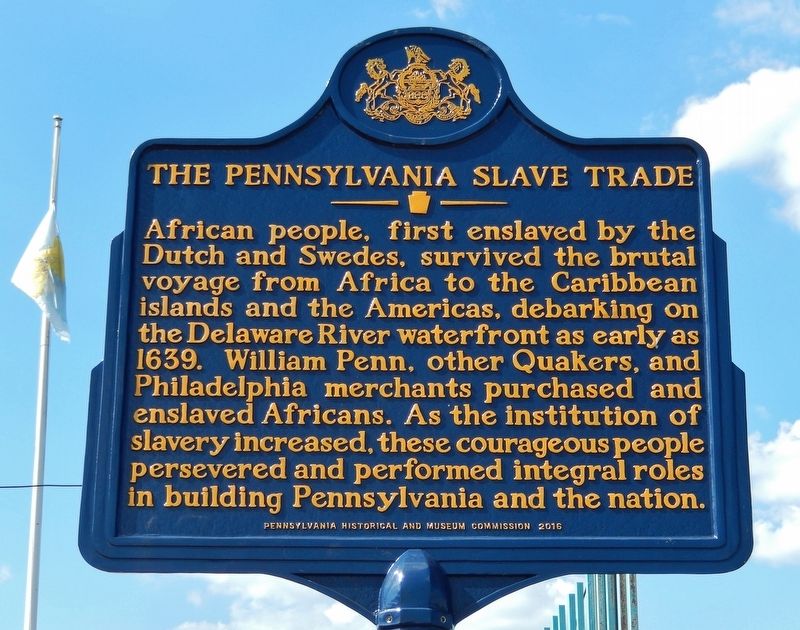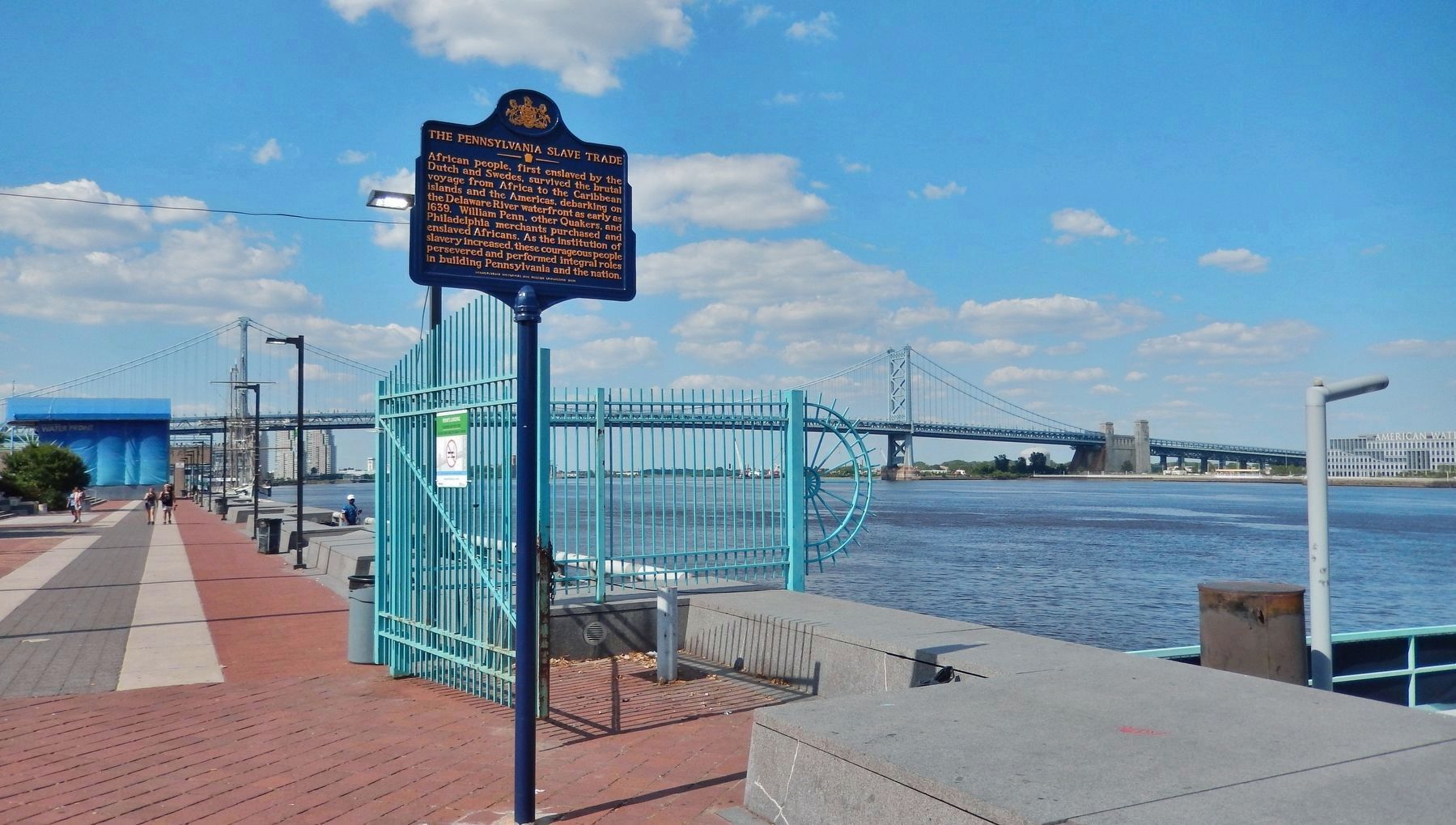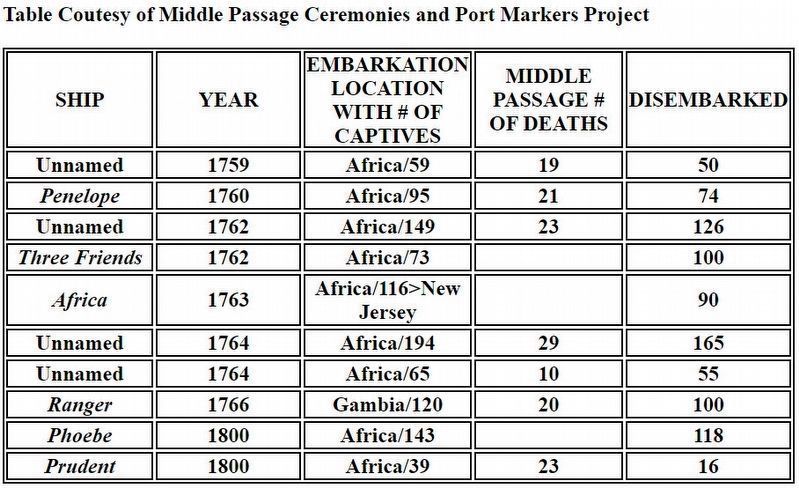Penn's Landing in Philadelphia in Philadelphia County, Pennsylvania — The American Northeast (Mid-Atlantic)
The Pennsylvania Slave Trade
Erected 2016 by Pennsylvania Historical and Museum Commission.
Topics and series. This historical marker is listed in these topic lists: African Americans • Colonial Era. In addition, it is included in the Pennsylvania Historical and Museum Commission, and the Quakerism series lists. A significant historical year for this entry is 1639.
Location. 39° 56.779′ N, 75° 8.388′ W. Marker is in Philadelphia, Pennsylvania, in Philadelphia County. It is in Penn's Landing. Marker can be reached from South Christopher Columbus Boulevard near Chestnut Street (Penn's Landing Road), on the right when traveling north. Marker is located along the Penn's Landing Historic walk, on the waterfront, near the Independence Seaport Museum. Touch for map. Marker is at or near this postal address: 211 South Christopher Columbus Boulevard, Philadelphia PA 19106, United States of America. Touch for directions.
Other nearby markers. At least 8 other markers are within walking distance of this marker. Glomar Explorer (within shouting distance of this marker); 1776 (within shouting distance of this marker); 1933 (within shouting distance of this marker); 1754 (within shouting distance of this marker); 1751 (within shouting distance of this marker); 1804 (within shouting distance of this marker); 1902 (within shouting distance of this marker); 1839 (within shouting distance of this marker). Touch for a list and map of all markers in Philadelphia.
Also see . . .
1. Slavery in Pennsylvania. William Penn was granted his colony in Pennsylvania in 1681. Though he flooded the "Holy Experiment" with Quakers whose descendants would later find their faith incompatible with slaveholding, the original Quakers had no qualms about it. Penn himself owned slaves, and used them to work his estate, Pennsbury. In Penn's new city of Philadelphia, African slaves were at work by 1684, and in rural Chester County by 1687. Between 1729 and 1758, Chester County had 104 slaves on 58 farms, with 70 percent of the slaveowners likely Quakers. (Submitted on June 28, 2019, by Cosmos Mariner of Cape Canaveral, Florida.)
2. How and where human beings were bought, sold and owned in Center City Philadelphia. (Submitted on June 28, 2019, by Cosmos Mariner of Cape Canaveral, Florida.)
3. Middle Passage Ceremonies and Port Markers Project
. (Submitted on March 30, 2020, by John Bloomfield of Palm Coast, Florida.)
Additional commentary.
1. Middle Passage Narrative
Serving as a major mid-Atlantic commercial and shipping center, the city of “Brotherly Love” supplied enslaved Africans locally and to neighboring states – Delaware and New Jersey. Philadelphia has the distinguished status of being the first of the former U.S. state capitals to publicly acknowledge its role in Middle Passage history with a marker. Because of its Quaker population, the gradual abolition of slavery in Pennsylvania was enacted in 1780.
There are several places of note related to people of African descent:
• Mother Bethel African Methodist Episcopal (A.M.E) Church founded by Richard Allen (1794)
erected on the oldest parcel of land continuously owned by African Americans in the U.S.;
• The nation’s first major museum of African American history – The African American Museum (1976);
• The Philadelphia Tribune - oldest daily newspaper serving the African American community;
• First statue representing an African American on public property;
• African Episcopal Church of St. Thomas, the nation’s first Black Episcopal church, founded in 1792 by Bishop Absolom Jones.
The
transatlantic human trade marker was installed in 2015 at historic Penn’s Landing (near Independence Seaport Museum) where the exhibit Tides of Freedom: African Presence on the Delaware River illustrates the 300-year story of the Middle Passage, enslavement, emancipation, Jim Crow, and civil rights with artifacts, documents, and first-person accounts.
— Submitted March 30, 2020, by John Bloomfield of Palm Coast, Florida.
Credits. This page was last revised on February 2, 2023. It was originally submitted on June 28, 2019, by Cosmos Mariner of Cape Canaveral, Florida. This page has been viewed 573 times since then and 113 times this year. Photos: 1, 2. submitted on June 28, 2019, by Cosmos Mariner of Cape Canaveral, Florida. 3. submitted on March 30, 2020, by John Bloomfield of Palm Coast, Florida.


